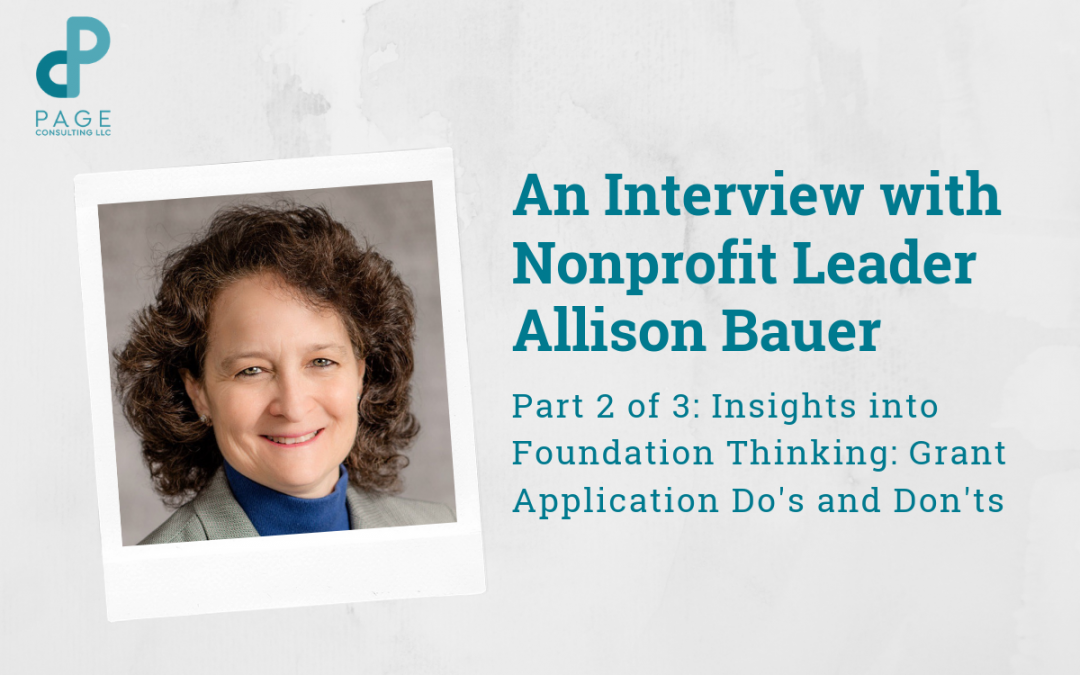In our most recent post we sat down with industry expert, Allison Bauer, to discuss emerging trends in philanthropy and the power of nonprofit data. In Part 2 of our interview below, we dive straight into the do’s and don’t’s of grant applications and discuss how you can best position your organization for success in foundation fundraising – regardless of mission, services, or budget size.
Allison is the former Senior Director for Health and Wellness at The Boston Foundation as well as the former Director for the Bureau of Substance Addiction Services for the State of Massachusetts. Recently, Allison joined Root Cause as Director of Partner Relations while continuing an expanded role as associate professor at Northeastern University.
This is the second part of a three-part series.
Sonya: In our previous discussion you described some great organizations – both those that promote system change and those that are doing incredible work serving people and opening access. And we’ve learned that even in the face of new trends in philanthropy, there are funding opportunities available for both.
So let’s talk about the other side of the coin here. What would you consider to be red flags if you were meeting with a nonprofit or evaluating a grant application? What would make you wary of funding an organization?
Allison: I’d say the red flags fall into two buckets. The first is financial and operational. When we [at The Boston Foundation] reviewed a nonprofit’s financial statement and 990, it didn’t need to show that they had a lot of money, but it did need to show that they had good management of that money.
If I saw cash flow issues or poor management – issues that demonstrated money was flowing to areas other than the mission in a concerning way – that would be a big red flag. Similarly, if an organization came in with a request that was a significant portion of their overall organizational budget, that would be concerning from a management standpoint.
The second is around personnel. If you had a revolving door of leadership, that’s a red flag to me. The same on the staff level. You may have a leader who stays but that individual can’t retain staff – that points to potential problems. We know there’s going to be turnover in the nonprofit space for a variety of reasons, but you can get a feel for natural movement and unnatural movement.
…IF an organization came in with a request that was a significant portion of their overall budget, that would be coNcerning from a management standpoint.
Sonya: Any other concerns you would have as a foundation reviewing a grant application?
Allison: On a grant application specifically, a reviewer wants to see a strong use of data that points to need and related outcomes, and you want to see those outcomes align with the organization’s reality and reach.
Don’t write a grant for something you don’t really do just because it’s something you think the foundation wants – that’s mission creep. Don’t write a grant that says you’re going to do something bigger than you actually can because you think that’s what you need to do to get the dollars. That’s going to show me that you’re not being realistic.
The last thing is that foundation applications ask specific questions. Answer them! Don’t answer something else because you are trying to stay on message or want to get a specific point across; that’s what follow up is for.
Don’t write a grant that says you’re going to do something bigger than you actually can because you think that’s what you need to do to get the dollars. That’s going to show me that you’re not being realistic.
Sonya: One area I’ve noticed where there’s a bit of a knowledge gap is in using the “Statement of Need” section of a grant application to build your case.
Here, a nonprofit needs to use data to prove there’s a problem, and then demonstrate that there’s a model or comparable program out there that has proven to effectively meet this need – or a need that is closely aligned with their area or population of focus.
From here, the nonprofit is positioned to ask a foundation to invest in their program and the model they’ve outlined – making the case that the foundation’s investment will allow them to move forward with confidence and get the outcomes they want to. So there is a fine balance.
Allison: It is a fine balance. Because sometimes you may be making the case that actually there isn’t any model out there that’s been proven to solve this problem, so here’s what you’re recommending based on what you do know. And then you ask the foundation to take the leap with you.
One of my favorite books in philanthropy is Bill Somerville’s Grassroots Philanthropy. What Bill Somerville said was that sometimes on the foundation side, you just have to say, you know what? This hasn’t been done before and no one knows if this is going to work or not, but I’m going to invest some small dollars in this anyway and see what happens.
Sonya: When you’re in competition with similar nonprofits for limited resources, there can be a real hesitancy to partner or do coalition building. Is there an advantage to partnering with other organizations in the same space specifically in an effort to secure grants?
The tension is that you also want to distinguish yourself and show that you are unique to potential funders but it seems that funders also want to see you partner with similar organizations. How do nonprofits achieve that balance, especially on a grant application?
Allison: One of my favorite examples of this is the Children’s Mental Health Campaign – which I worked on during my time at the state house – that was made up of the Massachusetts Society for the Prevention of Cruelty to Children (MSPCC), Boston Children’s Hospital, Parent Professional Advocacy League (PPAL), and many others.
They came to The Boston Foundation and said, “We don’t want you to support one of us; we want you to support the campaign.” Each of these organizations brought a unique component to the campaign and not only did The Boston Foundation invest in it, Blue Cross Blue Shield of Massachusetts invested in it, as well as several family foundations. All of these funders saw the value in these nonprofits putting aside their own individual agendas and fundraising needs to bring in money together and pool resources to the campaign.
Some organizations provided community-based services, some addressed more acute needs, others did training manuals for police. This is now a statewide network of advocates that is wildly successful.
The Children’s Mental Health Campaign is exactly the type of work that drew me to Root Cause in my current position. One of the primary tenets of Root Cause is Collective Action, where our organization helps cultivate common purpose around networks of organizations and community members. When we talk about trends in philanthropy, this work is absolutely central because of the intense competition for resources.
All of these funders saw the value in these nonprofits putting aside their own individual agendas and fundraising needs to bring in money together and pool resources to the campaign.
Join us in just two weeks for Part 3 of my interview with Allison: Supporting Nonprofits & the Future of Philanthropy. Here, Allison walks us through her new role at Root Cause and explains how nonprofits and foundations can come together to effectively address societal issues with a sense of common purpose. She’ll offer further tips on how to use data and evidence to support your nonprofit’s work on a grant application and explain the growing importance of equity and partnership in the nonprofit sector.
Curious to learn more? Sign up for our newsletter today to stay up to date on the latest grants-related topics.

